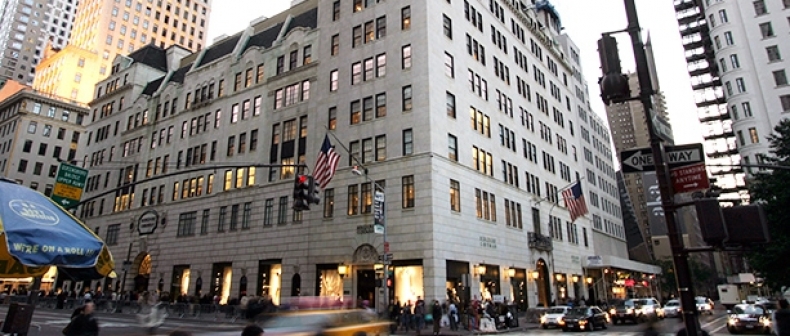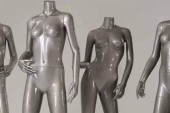
New Yorkers are good talkers, as are people in fashion. This goes a long way in explaining the success of recent documentaries about the fashion industry, like The September Issue and Bill Cunningham New York. For his tribute to the luxury goods institution Scatter My Ashes At Bergdorf’s, director Matthew Miele assembled the usual suspects from Manhattan’s glitterati: Oscar de la Renta, Diane von Fürstenberg, Patricia Field, Iris Apfel, Tom Ford, the Olsen twins, and many, many others. Too bad none of them had anything to say.
The film sought not to offend the owners of Bergdorf Goodman, the interview subjects, or even the shopaholics in its audience. (I can’t be sure there were actual Bergdorf customers in the Bloor Cinema audience, but some of them definitely acted like they were important. After a woman in front of me changed her mind about a seat and got up to move, the woman next to her preemptively declared, “I’m not standing up again.” Evidently her bag of popcorn and small cup of water weighed her down.)
Before starting the feature, the theatre showed trailers for documentaries on veterans suffering from post-traumatic stress disorder and mass genocide in Bangladesh. Played before a film about shopping and shoes, the juxtaposition was darkly humourous.
The movie starts with a shot of a pleasant, simple home presumably in the suburbs of New York. A grey-haired man sips his morning coffee before driving downtown. We’re suddenly plunged into a Sex and the City movie, pulsing music matched with frantic shots of crowded sidewalks, window displays, clicking high heels, and swinging shopping bags. As he puts on his uniform, we discover the man is a doorman at Bergdorf Goodman. We learn neither his name nor what his job is like. As the opening credits finish, he vanishes. We never hear from him again.
As with many a New York institution, the history of Bergdorf Goodman, founded in 1899 by Herman Bergdorf who later partnered with Edwin Goodman, is based as much on myth than fact. We see this early on when soap star Susan Lucci tells the filmmaker she overheard two French tourists speaking about how, when they die, they’d like their ashes scatted at Bergdorf’s.
“Are you kidding?” the director asks. “Do you know the name of this movie?”
The quote originated from a New Yorker cartoon by Victoria Roberts. The cartoonist says she never considered writing, “Scatter my ashes at Macy’s or Bloomingdale’s. It had to be Bergdorf’s.” Why it had to be Bergdorf’s and what makes the store so different from the other flagships people who have never even been to New York have heard of (Barneys, Saks Fifth Avenue, Neiman Marcus) should be the main query of the film. Other than discussing Bergdorf’s tradition of stocking very expensive merchandise (a sales associate claims they can’t keep a pair of sparkly “sexy Dorothy” heels in stock, despite them costing $6,000) the film fails to answer this. It’s the role of documentary filmmakers to ask uncomfortable questions and probe messy truths. If a film can be as uncritical as an advertorial in a glossy magazine, it complicates the Bloor Cinema’s petition for documentary film to be recognized as Canada’s official art form.
We’re treated to a series of doting testimonials from designers both young (Thakoon, Kate and Laura Mulleavy, Michelle Obama-favourite Jason Wu) and established (Karl Lagerfeld, Vera Wang, Giorgio Armani, who I admire for being the only foreigner to not conduct his interview in English.) The accounts are basically the same–getting your clothes in Bergdorf’s is a big deal. The best story came from Michael Kors, who was discovered by then-Vice President of fashion Dawn Mello designing windows across the street. The best fashion documentaries cut through the glamorous facade of industry insiders like Bill Cunningham, Grace Coddington, and Isaac Mizrahi to show us a bit of the real person. Everyone in this film keeps the audience at arm’s length.
Nowadays the role of kingmaker (or queenmaker, if you will) falls to Linda Fargo, Senior Vice President and Director of Women’s Fashion. Fargo’s Colgate-white hair may recall Miranda Priestly, but the film presents her as the anti-Anna Wintour, the tastemaker with a warm smile and a nurturing attitude. In one of the only moments of ‘drama’ caught on camera, Fargo must let down a designer with the news that Bergdorf’s is not ready to carry them. “We’ll keep in touch” is the closest she gets to saying ‘No.’
That gets to the root of the problem with the interview subjects. The established designers are all too grateful to the store to say anything negative, and the up-and-coming designers who’ve been turned down still want to get in. Domenico Dolce and Stefano Gabbana say that their decision to sell at a competitor when they first made it big resulted in Bergdorf’s not carrying them for the ten years. Were Bergdorf’s managers petty and vindictive, or was this normal procedure? The filmmaker doesn’t find out. Halston, who was the head milliner for Bergdorf’s at the time he designed Jackie Kennedy’s pillbox hats, had a falling out with President Andrew Goodman after he began selling his women’s line at JC Penny. We don’t hear the designer’s side of the story as he died in 1990.
The documentary’s technique of telling the history of the store in fits and starts means it’s unclear which Goodman (Andrew or his father Edwin) should be credited with turning Bergdorf’s into a fashion mecca. We do learn that Andrew and his wife lived on the top floor of the store for years, although they had to be registered as janitors to get around zoning bylaws.
In addition to Fargo, the main Bergdorf employees we meet are personal shopper Betty Halbreich and window dresser David Hoey, both of who could be subjects of their own documentaries. (“I never look at the windows,” Halbreich admits in her interview. “They’re a big deal for this store,” the director says. “I know!” she whispers, guiltily.)
Halbriech has the quick tongue of a comedian and the large, innocent eyes of the Gerber Baby, which allow her to get away with saying blunt things to her clients like, “That looks terrible, but it’s better than what you came in with, so you better buy it.” Unfortunately, almost none of her shoppers wanted to be followed around with cameras so we don’t get to see her in action. We’re the Say Yes to the Dress generation–we expect changing room drama. I suspect women were weary of filmmakers taping them trying on clothing worth thousands as dollars as much as they were trying on things that didn’t fit.
The movie has a funny relationship with money. It’s everywhere but never talked about. Mentioning it appears as much as a faux pas as much as mentioning Barneys. When the director asked the sales associate how much the pair of “sexy Dorothy” heels cost he answered, “Are you allowed to ask that?” Another employee of Bergdorf’s talked about how the Bernie Madoff scandal, followed by the economic collapse of 2008, hurt sales. She says that, even though some people are still having trouble buying milk, sales at Bergdorf have rebounded. What this says about the economic recovery of the United States is unaddressed. I highly doubt it’s only about the talent of Bergdorf’s personal shoppers.
Bergdorf’s is about aspiration and ascendancy. As one of the interview subjects says, it’s a physical inspiration for the American Dream. The documentary is a testament to what a lot of writers have said this summer–no need to feel nostalgic for the era of The Great Gatsby. We’re living in it.
Bergdorf’s is also about dreams, and nothing summarizes that so clearly as Hoey’s fairytale-like window displays. The film follows the construction and installation of the store’s animal-themed Christmas windows, and the filmmakers lovingly dwell on the brass birds, pearly polar bears, and moose covered in woven string with attention not paid to Bergdorf’s clothes. The ending of the film climaxes with the unveiling of the displays. They are magically beautiful. It’s too bad the documentary is so much like those windows–pretty to look at but only a few feet deep. We’d like to go inside, but plate glass as hard as diamonds locks us out.
____
Max Mosher writes about style for Toronto Standard. You can follow him on Twitter at @max_mosher_.
For more, follow us on Twitter @TorontoStandard or subscribe to our newsletter.













